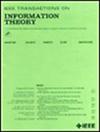On Correlation Distribution of Niho-Type Decimation d = 3(pm - 1) + 1
IF 2.2
3区 计算机科学
Q3 COMPUTER SCIENCE, INFORMATION SYSTEMS
引用次数: 0
Abstract
The cross-correlation problem is a classic problem in sequence design. In this paper we compute the cross-correlation distribution of the Niho-type decimation关于 Niho-type decimation d = 3(pm -1)+1 的相关分布
交叉相关问题是序列设计中的一个经典问题。本文计算了任意素数 $p \ge 5$ 的 Niho-type decimation $d=3(p^{m}-1)+1$ 在 ${mathrm {GF}}(p^{2m})$ 上的交叉相关分布。此前,Xia 等人在一系列论文中只解决了 $p=2$ 和 $p=3$ 的问题。Xia 等人指出,对于 $p \ge 5$,这个问题的主要困难在于计算 p-ary Zetterberg 码中 "纯重 "为 5 的码字数。事实证明,这个计算问题可以通过麦克威廉斯特性转化为计算 pary Melas 码中最多权重为 5 的码字,其中最难的码字与文献中研究得很好的 K3 面有关,可以计算。当 $p\ge 7$ 时,有限域上的椭圆曲线理论在解决这个问题中也起着重要作用。
本文章由计算机程序翻译,如有差异,请以英文原文为准。
求助全文
约1分钟内获得全文
求助全文
来源期刊

IEEE Transactions on Information Theory
工程技术-工程:电子与电气
CiteScore
5.70
自引率
20.00%
发文量
514
审稿时长
12 months
期刊介绍:
The IEEE Transactions on Information Theory is a journal that publishes theoretical and experimental papers concerned with the transmission, processing, and utilization of information. The boundaries of acceptable subject matter are intentionally not sharply delimited. Rather, it is hoped that as the focus of research activity changes, a flexible policy will permit this Transactions to follow suit. Current appropriate topics are best reflected by recent Tables of Contents; they are summarized in the titles of editorial areas that appear on the inside front cover.
 求助内容:
求助内容: 应助结果提醒方式:
应助结果提醒方式:


